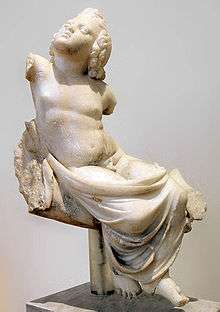Ploutonion
For the radioactive chemical element, see plutonium.

The Divine Child Ploutos (1st century)
A ploutonion (Ancient Greek: Πλουτώνιον, lit. "Place of Pluto") or plutonium (from the Latin) is a sanctuary specially dedicated to the ancient Greek and Roman god Pluto (better known as Hades ). Only a few such shrines are known from classical sources, usually at locations that produce poisonous emissions and were considered to represent an entrance to the underworld.[1]
- At Eleusis, the ploutonion was near the north entrance to the sacred district (temenos). It was built by Peisistratos in the 6th century BC and rebuilt two centuries later, when the Eleusinian mysteries were at the height of their influence. The cave was the traditional site of the birth of the Divine Child Ploutos.[2]
- The Greek geographer Strabo mentioned three sites as having a ploutonion. One was on a hill between Tralleis and Nysa. Its precinct encompassed a sacred grove, a temple of Plouton and Persephone, and an adjoining cave called the Charonion, after the ferryman of the dead. According to Strabo, it "possesses some singular physical properties" and served as a shrine for healing and a dream oracle (incubation).[3]
- Pluto's Gate, the ploutonion at Phrygian Hierapolis (modern Pamukkale in Turkey), was connected to the local cult of Cybele. Inhaling its vapors was said to be lethal to all living things except the Galli, the goddess's eunuch priests.[4] During the Roman Imperial era, the cult of Apollo subsumed existing religious sites there, including the ploutonion. Archaeological excavations in the 1960s showed that the ploutonion had been located within the sacred precinct of Apollo: "it consisted of a natural opening along a wall of travertine, leading to a grotto in which streams of hot water gushed forth to release a noxious exhalation". This site was also associated with a dream oracle; the Neoplatonist Damascius dreamed that he was Attis in the company of the Great Mother.[5]
- Strabo further records that Lake Avernus in Italy had been taken as a ploutonion because the gases it produced were so noxious that they overwhelmed birds flying overhead. According to earlier sources, he says, this was the oracle of the dead (nekumanteion) sought by Odysseus in Book 11 of the Odyssey; Strabo, however, seems not to have himself regarded Avernus as a ploutonion.[6]
See also
- Avernus
- Pluto's Gate (the ploutonion at Hierapolis)
References
- ↑ Karl Kerényi, Eleusis: Archetypal Image of Mother and Daughter (Princeton University Press, 1967, translated from the original German of 1960), p. 80 online; Christiane Sourvinou-Inwood, "Reconstructing Change: Ideology and the Eleusinian Mysteries," in Inventing Ancient Culture: Historicism, Periodization and the Ancient World (Routledge, 1997), p. 137; Georg Luck, Arcana Mundi: Magic and the Occult in the Greek and Roman Worlds (Johns Hopkins University Press, 1985, 2006, 2nd ed.), p. 505 online.
- ↑ Bernard Dietrich, "The Religious Prehistory of Demeter's Eleusinian Mysteries," in La soteriologia dei culti orientali nell' Impero Romano (Brill, 1982), p. 454.
- ↑ Strabo 14.1.44; "Summaries of Periodicals," American Journal of Archaeology 7 (1891), p. 209 online.
- ↑ Ian Rutherford, "Trouble in Snake-Town: Interpreting an Oracle from Hierapolis-Pamukkale," in Severan Culture (Cambridge University Press, 2007), p. 449
- ↑ Frederick E. Brenk, "Jerusalem-Hierapolis. The Revolt under Antiochos IV Epiphanes in the Light of Evidence for Hierapolis of Phrygia, Babylon, and Other Cities," in Relighting the Souls: Studies in Plutarch, in Greek Literature, Religion, and Philosophy, and in the New Testament Background (Franz Steiner, 1998), pp. 382–384 online, citing Photius, Life of Isidoros 131 on the dream.
- ↑ Strabo C244–6, as cited by Daniel Ogden, Magic, Witchcraft, and Ghosts in the Greek and Roman Worlds: A Sourcebook (Oxford University Press, 2002), pp. 190 –191.
This article is issued from Wikipedia - version of the 10/19/2016. The text is available under the Creative Commons Attribution/Share Alike but additional terms may apply for the media files.